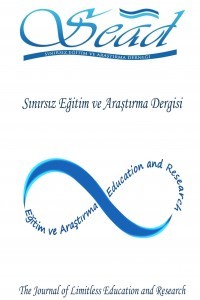Parçacık Fiziği Öğrenme Kazanımları
Son yıllarda dünyamızda parçacık fiziği alanında çok sayıda araştırma ve deney yapılmakta, önemli sonuçlara ulaşılmaktadır. Araştırma sonuçları eğitim alanına aktarılmakta, ders programları ve okutulan kitaplar güncellenmektedir. Parçacık fiziği konusu Lise Fizik Dersi Öğretim Programı son sınıf 4. ünitede verilmektedir. Araştırmada Atom Fiziğine Giriş ve Radyoaktivite ünitesinde verilen parçacık fiziği öğrenme kazanımları bilimsel ve eğitsel yönden incelenmiştir. Nitel araştırma yöntemlerinden doküman incelemesi yöntemi ile önce ilgili ünitede verilen konular ve kazanımlar belirlenmiştir. Ardından kazanımların nicelik ve nitelik durumu, bilimsel, eğitsel özellikleri ile güncelliği değerlendirilmiştir. Daha sonra kazanımların program amaçlarıyla uyumlu olup olmadığı karşılaştırılmıştır. Araştırma sonunda kazanımların bilgi öğretimine yönelik olduğu, bilimsel beceri ve yetkinliklerin ikinci planda kaldığı, önerilen öğretim yöntem ve tekniklerin yetersiz, kazanımların program amaçlarını sınırlı düzeyde karşıladığı görülmüştür. Ülkemizde etkili bir parçacık fiziği öğretimi için lise fizik ders programının güncellenmesi, öğrenme kazanımlarının programla uyumlu olması, sayısal, bilimsel ve eğitsel yönden iyi belirlenmesi önerilmiştir. Ayrıca öğretim sürecinde araştırma, deney, gözlem, sınıflama, karşılaştırma, sorgulama gibi becerilere ağırlık verilmesi, güncel yöntem ve tekniklerle, bilgi ve iletişim teknolojilerinden yararlanılması önerilmiştir.
Anahtar Kelimeler:
Parçacık fiziği, Fizik öğretim programı, Kazanımlar
Learning Outcomes of Particle Physics
In recent years, many researches and experiments have been carried out in the field of particle physics in our world, and important results have been achieved. The results of the research are transferred to the field of education, the curricula and the books taught are updated. The subject of particle physics is given in the 4th unit of the High School Physics Curriculum. In the study, particle physics learning outcomes given in the Introduction to Atomic Physics and Radioactivity unit were examined scientifically and educationally. With the document analysis method, one of the qualitative research methods, the subjects and achievements given in the relevant unit were determined first. Then, the quantitative and qualitative status, scientific and educational features and actuality of the learning outcomes were evaluated. Then, it was compared whether the achievements were compatible with the program objectives. At the end of the research, it was seen that the learning outcomes were aimed at teaching knowledge, scientific skills and competencies were secondary, the suggested teaching methods and techniques were inadequate, and the outcomes met the program objectives at a limited level. For an effective particle physics teaching in our country, it has been suggested that the high school physics curriculum should be updated, the learning outcomes should be compatible with the program, and the numerical, scientific and educational aspects should be determined well. In addition, it is recommended to focus on skills such as research, experiment, observation, classification, comparison and questioning in the teaching process, and to benefit from information and communication technologies with current methods and techniques.
Keywords:
Particle physics, Physics curriculum, Learning outcomes,
___
- Anderson, L. W., & Krathwohl D. R. (2001). A taxonomy for learning, teaching, and assessing: A revision of bloom’s taxonomy of educational objectives. New York, USA, Longman.
- Avenas, P. (2017). À propos de physique, https://www.lajauneetlarouge.com/a-propos-de Physique/ adresinden 13.12.2022 tarihinde ulaşılmıştır.
- Council of Europe (2008). Recommendation of the European Parliament and of the council of 23 April 2008 on the establishment of the European qualifications framework for lifelong learning, (Text with EEA relevance), https://eur-lex.europa.eu › ALL sitesinden 14.10.2022 tarihinde erişilmiştir.
- Council of Europe (2009). Recommendation of the European Parliament and of the council of 18 June 2009 on the establishment of a European Credit System for Vocational Education and Training (ECVET), https://eur-lex.europa.eu › ALL sitesinden 14.10.2022 tarihinde erişilmiştir.
- Donnelly, R., & Fitzmaurice, M. (2005) Designing modules for leraning. In G. O’Neill, S. Moore, & M. McMullin (Eds.), Emerging issues in the practice of university learning and teaching, all Ireland society for higher education, Dublin.
- Kamışcıoğlu, Ç. (2017). OPERA dedektöründeki nötrino-kurşun yüklü akim etkileşmelerinde hadron çokluk dağılımlarının incelenmesi. [Yayımlanmamış doktora tezi. Ankara Üniversitesi.
- Kamışcıoğlu, Ç. (2019). Araştırma yönüyle parçacik fiziğindeki gelişmeler, F. Güneş & A. D. Işık (Ed.), Araştırma ve öğrenme İçinde (s.73-84). Sınırsız Eğitim ve Araştırma Derneği Yayınları.
- Kamışcıoğlu, Ç. (2020). Parçacık fiziğindeki gelişmeler ve yönelimler. S. Benzer & B. Topuz (Ed.) Güncel fen bilimleri çalışmaları içinde (s. 43-61). Akademisyen Kitabevi.
- Kamışcıoğlu, Ç. (2022). Investigation of high school textbooks in terms of particle physics. Parçacık fiziği açısından lise ders kitaplarının incelenmesi. The Journal of Limitless Education and Research, Sınırsız Eğitim ve Araştırma Dergisi, 7(1), 131 - 167.
- MEB. (2018a). Ortaöğretim fizik dersi (9,10,11 ve 12. Sınıflar) öğretim programı. Ankara.
- MEB. (2018b). Fen lisesi fizik dersi (9,10,11 ve 12. Sınıflar) öğretim programı. Ankara.
- Türk, O. & Karadağ, M. (2022). Fen lisesi 12. sınıf fizik ders kitabının bilimsel içerik bakımından incelenmesi. Erzincan Üniversitesi Eğitim Fakültesi Dergisi, 24(3),417-431.
- Wach, E., & Ward, R. (2013). Learning about qualitative document analysis. https://opendocs.ids.ac.uk/opendocs/bitstream/handle/20.500.12413/2989/PP%20InBrief%20%2013%20QDA%20FINAL2.pdf?sequence=4. 03.02.2023 tarihinde erişilmiştir.
- Yiğit, N. (2004). Fizik öğretim programı ve uygulamalarının öğretmen - öğrenci görüşleri açısından değerlendirilmesi. Ondokuz Mayıs Üniversitesi Eğitim Fakültesi Dergisi, 17, 88-96.
- Yayın Aralığı: Yılda 3 Sayı
- Başlangıç: 2016
- Yayıncı: Sınırsız Eğitim ve Araştırma Derneği
Sayıdaki Diğer Makaleler
Descriptive Content Analysis of Digital Literacy Studies in Education in Türkiye
Hacı Mehmet YEŞİLTAŞ, Meral ÇELİKOĞLU, Erol TAŞ
Öğretmen Adaylarının Dijital Ortamda Yazmaya İlişkin Tutumlarının ve Görüşlerinin Değerlendirilmesi
Uzaktan Eğitim Öğrencilerinin Yüz Yüze Sınav Deneyimleri Üzerine Bir Araştırma
Hanife ÇİVRİL, Emine ARUĞASLAN
Çıkarım Nedir? Nasıl Geliştirilir?
